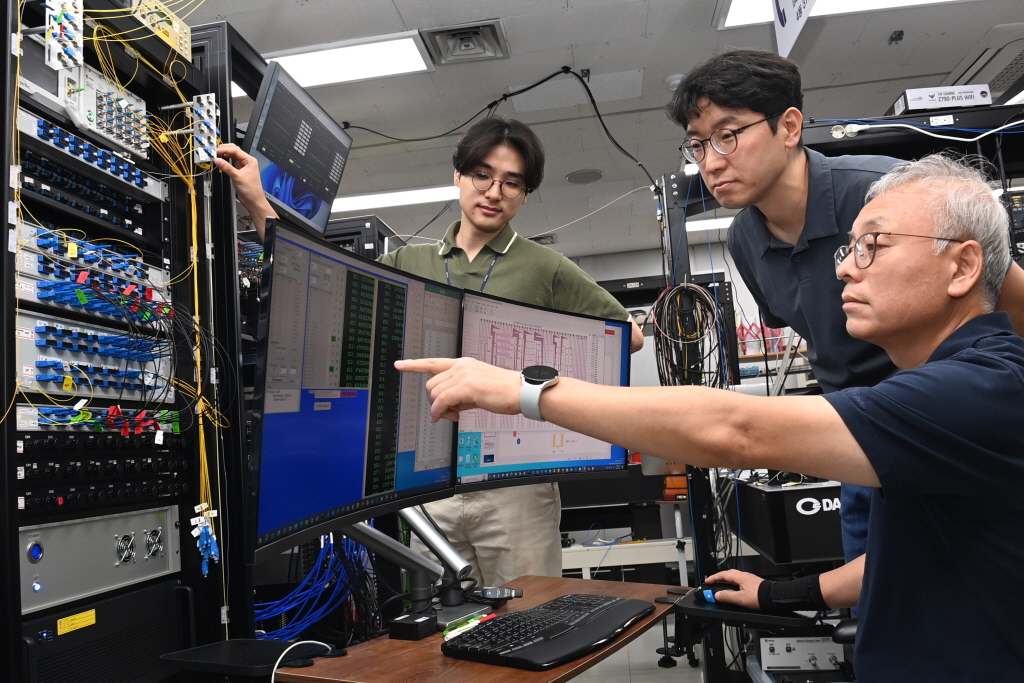한국전자통신연구원(ETRI)이 실리콘포토닉스 양자칩을 확장해 광자 8개를 제어할 수 있는 시스템을 완성하고 8개의 광자에 의해 발생하는 양자 현상들을 실험 중이다. 세계에서 처음으로 빛 알갱이 즉, 광자(光子)방식의 8광자 큐비트(Qubit) 집적회로 칩 개발에 성공한 것이다.

▲ETRI 연구진이 양자컴퓨팅 8광자 큐비트 칩 개발 관련 시연하는 모습
세계 최초 8개 광자 간섭하며 얽히는 집적회로 구현
한국전자통신연구원(ETRI)이 세계에서 처음으로 빛 알갱이 즉, 광자(光子)방식의 8광자 큐비트(Qubit) 집적회로 칩 개발에 성공했다.
ETRI는 실리콘포토닉스 양자칩을 확장해 광자 8개를 제어할 수 있는 시스템을 완성하고 8개의 광자에 의해 발생하는 양자 현상들을 실험 중이라고 4일 밝혔다.
광자기술을 적용해 시·공간 상에서 양자의 얽힘 구현을 가능케 만든 셈이다.
연구진은 그동안 실리콘포토닉스 양자칩 연구를 꾸준히 추진해 왔다.
지난해 연구진은 KAIST 및 이탈리아 트렌토(Trento) 대학과 협력해 광자 4개를 제어할 수 있는 4큐비트 실리콘 포토닉스 칩에서 2큐비트와 4큐비트 양자 얽힘을 구현해 세계 최고의 성능을 보여줬다.
본 성과는 세계적인 학술지 ‘포토닉스 리서치(Photonics Research)’와 ‘에이피엘 포토닉스(APL Photonics)’에 각각 게재됐다.
ETRI는 2큐비트 및 4큐비트 양자얽힘 논문 발표 이후 8큐비트로 확장된 칩을 제작해 6큐비트 양자얽힘 현상도 이번에 확인했다.
연구진은 이번 8큐비트 생성 및 제어 양자칩을 개발해 6큐비트 양자얽힘 현상 확인 결과가 실리콘 기반 광기술(Si Photonics) 집적회로 기준으론 세계최초의 성과라는데 큰 의미가 있다고 말했다.
특히 광자가 가는 길을 두 개로 나누어 위로 가면 0, 아래로 가면 1로 표현하는데, 4큐비트는 빛이 가는 길이 위와 아래를 합쳐 총 8개, 8큐비트는 16개인 셈이다.
연구진은 큐비트 간 양자적으로 서로 강하게 얽힌 상태를 칩 내에서 구현했다.
연구진이 성과를 낸 광자기반 기술은 양자컴퓨터를 만드는 방법 중 가장 유력한 기술 중 하나다.
손톱만 한 크기의 실리콘 칩에 광자기반 양자 회로를 포함한 실리콘 포토닉스 양자 칩을 만들고, 여러 개의 양자 칩들을 네트워크로 연결해 범용 양자컴퓨팅을 구현하는 기술이다.
특히 광자기반 양자컴퓨터는 빠른 속도, 상온 동작, 낮은 오류율, 확장성, 낮은 에너지 소비율 등의 장점이 있다.
양자 광원, 선형 광소자 및 단일광자 측정기 등을 활용, 광학 시스템에 인코딩된 양자정보를 조작, 측정한다.
ETRI는 광자생성기, 위상변조기, 스위치 등 다양한 광학소자를 이번 새로 만든 칩에 만들어 넣어 빛의 경로를 조절하여 양자 간섭을 하도록 하였다.
이로써 컴퓨터의 기본적 역할인 정보전달 및 변환 수행이 가능케 된다.
칩 내에는 비선형 광자 쌍생성 소스 8개와 광 경로를 조절하는 광스위치가 40여 개 들어 있으며 광스위치 중 20여 개는 양자 게이트 역할을 한다.
이로써 단일광자 검출기를 통해 양자 상태를 측정하는 양자컴퓨터의 기본 틀을 갖췄다.
연구진은 특히 서로 다른 방향에서 진입한 두 개의 광자가 만나면 서로에게 영향을 주어서 함께 뭉쳐서 진행하는 흥미로운 양자 현상인 홍-오우-만델(Hong-Ou-Mandel) 효과를 칩 내에서 측정했다.
연구진은 5mm×5mm 크기의 4큐비트 집적회로를 만들어 HOM 간섭 실험에 이어서 광자 두 개를 더한 4개의 광자의 경로가 얽히며 일어나는 양자 현상들을 논문에 발표했다.
현재는 10mm×5mm 크기의 8큐비트 집적회로를 만들어 총 8개의 광자에서 발생하는 양자 현상들을 연구 중이다.
연구진은 향후 기술의 완성도를 높여 올해 중 16큐비트 칩 개발에 도전하고, 이후 32큐비트로 확장 개발, 양자 기계학습(ML)을 포함한 양자컴퓨팅 응용 연구에 이용할 계획이다.
ETRI 윤천주 양자기술연구본부장은 “향후 기술적 완성도를 제고해 양자컴퓨터를 통해 외국의 사례처럼 5년 내 클라우드 서비스를 계획 중이다. 실험실 규모라도 시스템이 돌아가도록 만들어 새로운 영역의 학문개척에 나설 방침”이고 말했다.
이번 성과를 주도한 ETRI 양자컴퓨팅연구실 이종무 박사는 “양자컴퓨터의 실제적인 구현을 위한 연구가 전 세계적으로 앞다퉈 진행 중이다. 큐비트의 노이즈로 인한 연산 오류를 극복하는 양자컴퓨팅 구현과 상용화를 위해서는 아직도 많은 연구가 필요하다”고 밝혔다.
ETRI의 실리콘 포토닉스 양자 칩 연구는 ETRI 자체의 신개념연구사업(별칭묘목사업)인 “실리콘 포토닉스 기반 양자컴퓨터 탐색연구”및 한국연구재단의 양자컴퓨팅개발사업의 지원으로 연구개발 됐다.